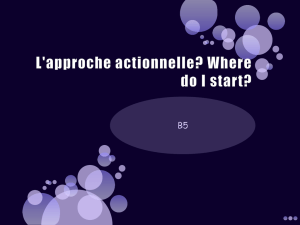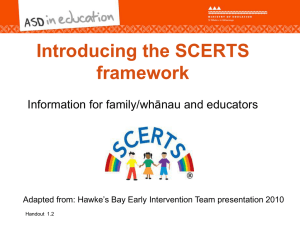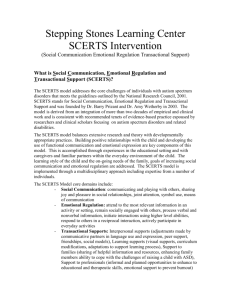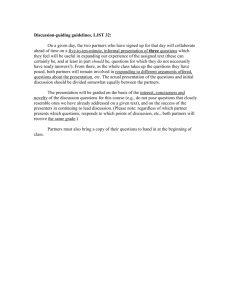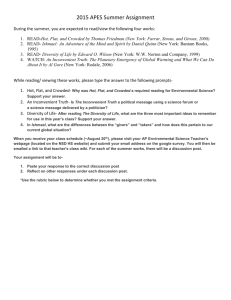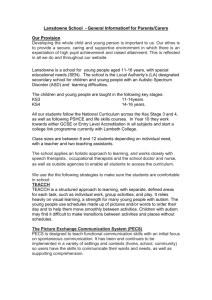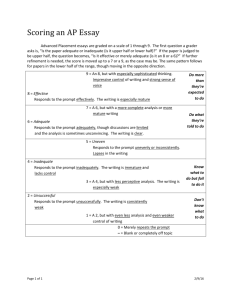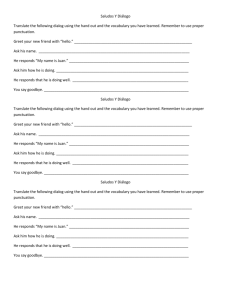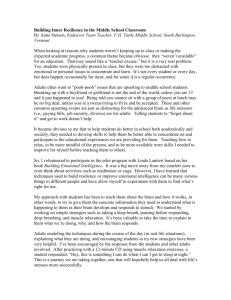Handout 2.2 - Using the SCERTS lens
advertisement
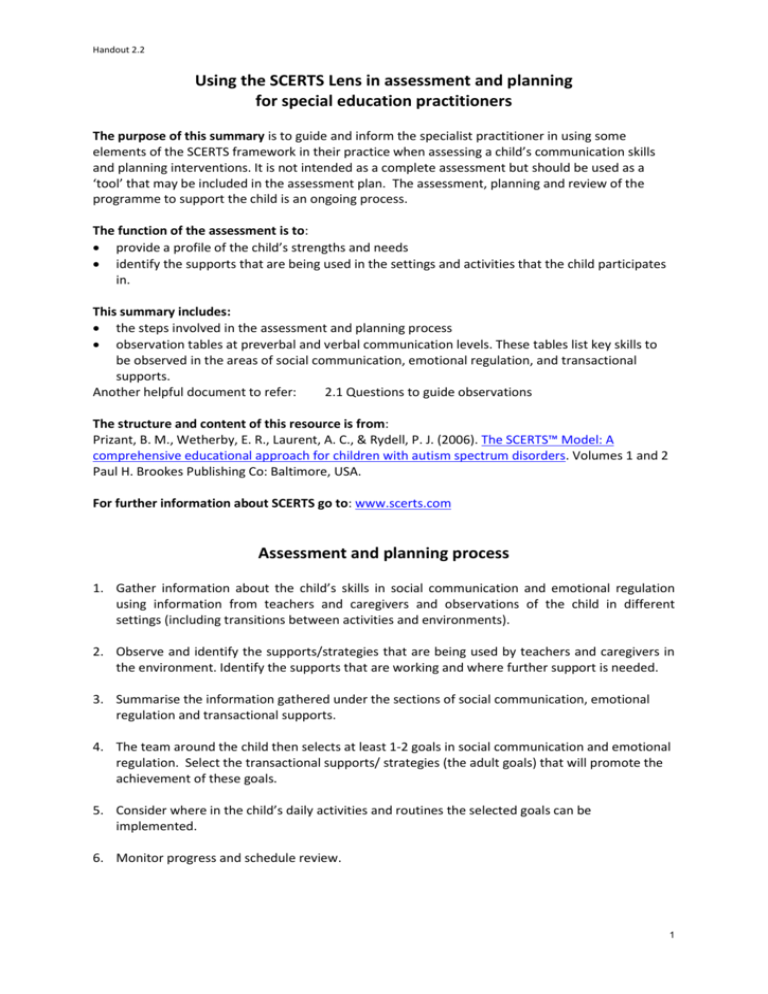
Handout 2.2 Using the SCERTS Lens in assessment and planning for special education practitioners The purpose of this summary is to guide and inform the specialist practitioner in using some elements of the SCERTS framework in their practice when assessing a child’s communication skills and planning interventions. It is not intended as a complete assessment but should be used as a ‘tool’ that may be included in the assessment plan. The assessment, planning and review of the programme to support the child is an ongoing process. The function of the assessment is to: provide a profile of the child’s strengths and needs identify the supports that are being used in the settings and activities that the child participates in. This summary includes: the steps involved in the assessment and planning process observation tables at preverbal and verbal communication levels. These tables list key skills to be observed in the areas of social communication, emotional regulation, and transactional supports. Another helpful document to refer: 2.1 Questions to guide observations The structure and content of this resource is from: Prizant, B. M., Wetherby, E. R., Laurent, A. C., & Rydell, P. J. (2006). The SCERTS™ Model: A comprehensive educational approach for children with autism spectrum disorders. Volumes 1 and 2 Paul H. Brookes Publishing Co: Baltimore, USA. For further information about SCERTS go to: www.scerts.com Assessment and planning process 1. Gather information about the child’s skills in social communication and emotional regulation using information from teachers and caregivers and observations of the child in different settings (including transitions between activities and environments). 2. Observe and identify the supports/strategies that are being used by teachers and caregivers in the environment. Identify the supports that are working and where further support is needed. 3. Summarise the information gathered under the sections of social communication, emotional regulation and transactional supports. 4. The team around the child then selects at least 1-2 goals in social communication and emotional regulation. Select the transactional supports/ strategies (the adult goals) that will promote the achievement of these goals. 5. Consider where in the child’s daily activities and routines the selected goals can be implemented. 6. Monitor progress and schedule review. 1 Handout 2.2 Observations in the area of Social Communication For the child who is preverbal and is not yet using words, pictures, or signs with meaning Joint Attention Observe if, how, when and with whom the child: Initiates and responds to others Engages in meaningful interactions with adults/peers Looks to see if a person is sharing their interest Looks in the direction of where another person is pointing Shows how he/she is feeling Requests food, objects, help, other actions Refuses/protests unwanted food, objects or actions Requests comfort Requests a social or “fun” game Takes turns Greets and farewells others “Comments” on objects, actions and events (e.g points, brings an object to show another person) Shares experiences Tries other ways of communicating if not understood Symbol Use Observe if, how, when and with whom the child: Imitates actions and sounds on request or spontaneously Follows cues (routines, visual, gesture, physical, environmental, photos, symbols) Uses exploratory actions on objects Uses objects to construct e.g. stacking, putting pieces together Uses familiar objects in simple pretend actions e.g. drinking from a cup Uses pretend actions with another person or doll figure Says words out of context with no obvious intent. Communicates with intent using gestures e.g. give, push away, point, head shake Communicates with intent using vocalisations Communicates with intent using “learned” routines Responds to own name Responds to a few words Responds to some frequently used phrases in familiar routines NB. The structure and content of this resource is sourced from: Prizant, B. M., Wetherby, E. R., Laurent, A. C., & Rydell, P. J. (2006). The SCERTS™ Model: A comprehensive educational approach for children with autism spectrum disorders. Volumes 1 and 2. Paul H. Brookes Publishing Co: Baltimore, USA. 2 Handout 2.2 Observations in the area of Emotional Regulation For the child who is preverbal and is not yet using words, pictures or signs with meaning 1. Mutual Regulation How the child responds to support from others to be actively engaged Observe if, how, when and with whom the child: Expresses happiness, sadness, anger, fear Responds to help and being comforted by partners Makes choices when offered by partner Seeks out and asks for comfort when upset and distressed Requests help when frustrated Responds to specific behavioural strategies when dysregulated (e.g. child allows himself to be put on the swing when upset, allows back rub when angry) Self Regulation What the child does to regulate emotional arousal to be actively engaged Observe if, how, when and with whom the child: Is available for learning and interacting with others Shows an interest in people and things in the environment Uses strategies to regulate his/her arousal level e.g. sensory motor actions, vocalisations, withdrawal. NB. The structure and content of this resource is sourced from: Prizant, B. M., Wetherby, E. R., Laurent, A. C., & Rydell, P. J. (2006). The SCERTS™ Model: A comprehensive educational approach for children with autism spectrum disorders. Volumes 1 and 2 Paul H. Brookes Publishing Co: Baltimore, USA. 3 Handout 2.2 Observations in the area of Social Communication For the child who is using some words, phrases, signs or symbols Joint Attention Observe if, how, when and with whom the child: Initiates interactions and responds to others participates in interactions with adults/peers Shares attention by looking between people and objects Looks in the direction of where another person is pointing Attracts attention to her/himself before communicating Shares how he/she is feeling Notices and understands the feelings of others Requests food, objects, help, other actions Refuses/protests unwanted food, objects or actions Requests comfort Requests a social or “fun” game Greets and farewells others Comments on objects, actions and events Asks questions about things Shares experiences in a conversational setting Tries other ways of communicating if not understood Symbol Use Observe if, how, when and with whom the child: Imitates actions, sounds and on request or spontaneously Follows cues (routines, visual, gesture, physical, environmental, photos, symbols) Responds to visual cues e.g. gestures, photos, symbols Uses objects/toys appropriately Is able to join in “pretend play” with others Uses a range of gestures with intent Uses a range of words and word combinations to communicate in the correct context Responds to own name Understands and responds to frequently used phrases in routines Understands and follows one part verbal instructions with visual cues Understands and follows one part verbal instructions without visual cues Understands a range of words and verbal concepts NB. The structure and content of this resource is sourced from: The SCERTS manuals, Volumes 1 and 2 Prizant, B. M., Wetherby, E. R., Laurent, A. C., & Rydell, P. J. (2006). The SCERTS™ Model: A comprehensive educational approach for children with autism spectrum disorders. Paul H. Brookes Publishing Co: Baltimore, USA. 4 Handout 2.2 Observations in the area of Emotional Regulation For the child who is using some words, phrases, signs or symbols Mutual Regulation How the child responds to support from others to be actively engaged Observe if, how, when and with whom the child: Expresses happiness, sadness, anger, fear Responds to help and being comforted by partners Makes choices when offered by partner Seeks out and asks for comfort when upset and distressed, or needs a break Requests help when frustrated Responds to specific behavioural or language strategies when dysregulated (e.g. child allows back to be rubbed when angry, follows a visual cue to take a break when frustrated) Self Regulation What the child does to regulate his/her emotional arousal to be actively calm and engaged Observe if, how, when and with whom the child: Is available for learning and interacting with others Is able to attend or participate in small group activities Uses specific strategies to regulate his/her levels of attention and focus e.g. sensory motor actions, language or withdrawal. Is interested in and joins in new situations Will rejoin an activity following a break What are the child’s signals or behaviour that indicates he/she is dysregulated or becoming dysregulated Are there differences in the way the child communicates when he/she is well regulated and motivated versus when he/she is dysregulated or upset? NB. The structure and content of this resource is sourced from: The SCERTS manuals, Volumes 1 and 2 Prizant, B. M., Wetherby, E. R., Laurent, A. C., & Rydell, P. J. (2006). The SCERTS™ Model: A comprehensive educational approach for children with autism spectrum disorders. Paul H. Brookes Publishing Co: Baltimore, USA. 5 Handout 2.2 Transactional Supports Observations of others interacting with the child Interpersonal Support Observe if, how and when the communication partner: Responds to the child e.g. follows the child’s lead, responds to the child’s communicative attempts, recognises signs of dysregulation Waits for the child to initiate Supports the child’s independence Behaviour is seen as having a purpose Encourages engagement e.g. gets down on child’s level Models appropriate behaviours and play Expands on child’s play and communication Adjusts level and amount of language used Learning Support Observe if, how and when the communication partner: Chooses an activity that allows the child to participate Provides a clear beginning and end to activity Ensures the child is motivated and interested Uses communication supports (e.g. sign, PECS, devices) Uses visual supports Plans transitions Modifies activities and learning environment e.g. adjusts the difficulty of the task, allows child to complete a task without distractions. What helps the child regulate, engage and participate? Which visual or environmental supports are most effective for supporting the child’s active engagement, regulation and participation? NB. The structure and content of this resource is sourced from: Prizant, B. M., Wetherby, E. R., Laurent, A. C., & Rydell, P. J. (2006). The SCERTS™ Model: A comprehensive educational approach for children with autism spectrum disorders. Volumes 1 and 2. Paul H. Brookes Publishing Co: Baltimore, USA. 6
